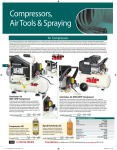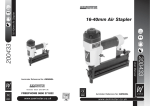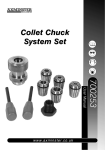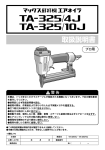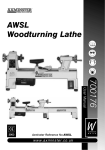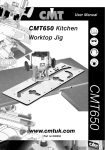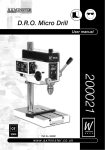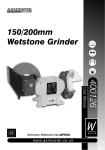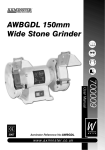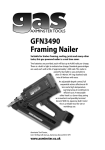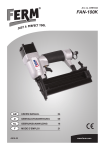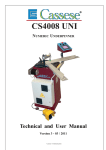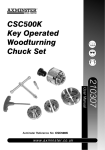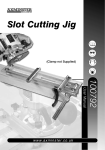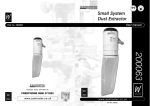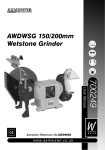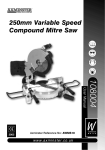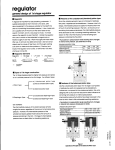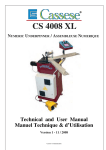Download 10-22mm Narrow Crown Stapler - Axminster Power Tool Centre
Transcript
600515 10-22mm Narrow Crown Stapler User Manual 600515 10-22mm Narrow Crown Stapler Axminster Reference No: AW422J W AXMINSTER W H I T E Axminster Devon EX13 5PH UK FREEPHONE 0800 371822 2000 www.axminster.co.uk 2000 Axminster Reference No: AW422J w w w. a x m i n s t e r. c o . u k W AXMINSTER W H I T E Illustrated Parts List... Index of Contents... W AXMINSTER W H I T E Page No. Index of Contents.......................................................................................................................... 02 Declaration of Conformity………….………........……..…………...............................................03 What’s in the Box………….………........……..………….................................................................04 General Instructions and Recommendations whilst using Air Equipment............................................................................................ 05-06-07 Specific Safety Instructions for the Stapler...................................................................08 Specifications….………........……..…………...............................................................................08 Identification and Description of the Stapler.................................................................09 Illustration and Parts Description of the Stapler............................................................ 10-11 Preparing your Stapler for Use......................................................................................11 Using your Air Stapler.................................................................................................... 12 Maintenance...................................................................................................................12 Troubleshooting............................................................................................................. 13 Illustrated Parts Breakdown...........................................................................................14 Illustrated Parts List........................................................................................................15 Saf sp irator Re Sa Two E R Ey y Helm fet Safety Protection Symbols r fety Viso Sa et st Mask Du F ootw ety r ea tiv e Glo tec s ve Def ende rs ar bly m n Asse Ma ro tectio eP n AXMINSTER W H I T E al W d Manu ea Pro ! The symbols shown on the cover of this manual advise that you wear the correct safety protection when using this machine. SAFETY!! FREEPHONE 0800 371822 15 W Declaration of Conformity... Illustrated Parts Breakdown... W AXMINSTER W H I T E AXMINSTER W H I T E Copied from CE Certificate The undersigned, O. Schiller authorised by Chong Qing Hong Yuan Pneumatic Tool Factory 107 Jienan Street Banan District Chong Qing, China declares that this product: Airnailer 422J manufactured by Chong Qing Hong Yuan Pneumatic Tool Factory is in compliance with the following standards or standardisation documents in accordance with Council Directives 98/37/EG / 98/37/EC 14 www.axminster.co.uk FREEPHONE 0800 371822 03 W What’s in the Box... Troubleshooting... AXMINSTER W H I T E W AXMINSTER W H I T E STOP USING THE TOOL IMMEDIATELY IF ANY OF THE FOLLOWING PROBLEMS OCCUR. SERIOUS PERSONAL INJURY COULD OCCUR. ANY REPAIRS OR REPLACEMENTS MUST BE DONE BY A QUALIFIED PERSON OR AN AUTHORISED SERVICE CENTRE ONLY. Model Number: 422J Quantity Item 1 No. 10-22mm Narrow Crown Stapler with PCL tail fitted. 1 No. Oil Bottle 1 No. 4mm Allen Key 1 No. 3mm Allen Key 1 No. Instruction Manual Having unpacked the tool and its accessories, please check the contents against the equipment list ”What's in the box”, if there are any discrepancies, please contact Axminster Power Tool Centre using the procedures laid down in the catalogue. Please dispose of the packaging responsibly; much of the material is bio-degradable. The tool is plated and painted to prevent corrosion, so there should be little or no cleaning required before use. Please read the Instruction Manual prior to using your new tool; as well as general precautions and instructions for use, there are daily and periodic maintenance recommendations to help you keep your tool on top line and prolong its life. Keep this Instruction Manual readily accessible for any others who may also be required to use the tool. PROBLEM Air leaking between body and front plate Damaged piston O-ring or bumper. Check and replace O-ring or bumper. Air leaking between body and cylinder cap. 1.Screw loose. 2.Damaged seal. 1.Tighten screws. 2.Check and replace seal. 1.Worn bumper. 2.Air pressure is too high. 1.Replace bumper. 2.Adjust the air pressure. 1.Insufficient oil. 2.Insufficient air supply. 3.Broken spring in cylinder cap. 4.Exhaust port in cylinder cap is blocked. 1.Lubricate as instructed. 2.Check air supply. 3.Replace spring. 4.Replace damaged internal parts. 1.Worn bumper or damaged spring (17,18). 2.Dirt in front plate. 3.Inadequate airflow to tool. 4.Worn or dry O-ring on piston. 5.Damaged O-ring on trigger valve. 6.Cylinder cap seal leaking. 1.Replace bumper or spring. 1.Joint guider is worn. 2.Fasteners are wrong size or damaged. 3.Magazine or front plate screws are loose. 4.Blade in piston assembly is damaged. 1.Replace joint guider. 2.Use the recommended and undamaged fasteners. 3.Tighten screws. 1.Worn blade in piston assembly. 2.Lack of power. 3.Slow cycling and loss of power. 1.Replace piston assembly. 2.Adjust to adequate air pressure. 3.Check cylinder cap spring for broken coils or reduced length. Check if exhaust port of cylinder cap is restricted. Air leaking at trigger area Blade driving fastener too deeply Runs slowly or has power loss Tool skips a fastener Tool will not drive fully down www.axminster.co.uk SOLUTION 1.Check and replace O-ring. 2.Check and replace trigger valve head. 3.Check and replace trigger valve stem, seal or O-ring. Fasteners continually “jam” 04 PROBLEM CAUSE 1.O-ring in trigger valve is damaged. 2.Trigger valve head is damaged. 3.Trigger valve stem, seal or O-ring are damaged. 2.Clean drive channel of front plate. 3.Check hose and compressor fittings. 4.Replace O-ring or lubricate. 5.Replace O-ring. 6.Replace seal. 4.Replace piston assembly 13 W General Safety Instructions and Recommendations whilst using Air Equipment... Using your Air Stapler... AXMINSTER W H I T E Using the Oil supplied in the small oiler bottle, put 2-3 drops into the air connector. It is always a good policy to add at least a drop of oil to the tool prior to the first use of the day, even if you have automatic oilers fitted to your supply system. If you do not have inline oilers, put 2-3 drops of oil into the tool first thing and then add 2 drops every 1-2 working hours. Connect the stapler to the hose line, check there are no leaks anywhere in the system. Organise a couple of pieces of scrap timber, preferably from the offcuts of the job you are doing, and the material to be stapled to it and staple the two? items together. Remember, there is no 'contact safety' fitted to this tool,the stapler will fire when the trigger is pressed. Carry out several trial staplings, and then check you are driving the staples to the correct depth. If not, adjust the air pressure (up or down) and carry out more trials, until you are satisfied. You may have to set the 'staple height setting plate' in order to limit how deeply the staple is actually driven, e.g. you may require to fasten cloth/covering, et al., to a frame work, and the material is not sufficiently robust to resist severing if the staple is driven through it? Maintenance... W AXMINSTER W H I T E Good Working Practices/Safety The following suggestions will enable you to observe good working practices, keep yourself and fellow workers safe and maintain your tools and equipment in good working order. ! WARNING!! KEEP TOOLS AND EQUIPMENT OUT OF THE REACH OF YOUNG CHILDREN Air Powered Tools Work Place/Environment. Keep the tool clean; it will enable you to more easily see any damage that may have occurred. Clean the tool with a damp soapy cloth if needs be, do not use any solvents or cleaners, as these may cause damage to any plastic components. Check the tool for damage both before and after work. If damage has occurred, have it repaired by a suitably qualified person. Check the air lines are undamaged, that supply galleries, spurs or connectors are not leaking. Keep the tool clean, and free from any splashes that may be picked up from current work, e.g. paint, glue ,etc. Frequent but not excessive oiling is the key to keeping your air tools working properly. Lack of oil and ingress of water will damage your air tools. If your air system is not fitted with water traps and in line oilers, make sure that the tool is not allowed to run 'dry' or to retain moisture. Keep the tool stowed safely away when not in use. Do not allow sawdust et al., to ingress the tool. Few drops of oil ( PNEUMATIC OIL ONLY) Keep the work area well lit and uncluttered as is practical, this includes personnel as well as material. Under no circumstances should CHILDREN be allowed in work areas. It is good practice to leave the tool disconnected from the air supply until work is about to commence, when it is not in use, or unattended. Once you are ready to commence work, remove any tools used in the setting up operations (if any) and place safely out of the way. Re-connect the tool. Carry out a final check e.g. the connector is tight 'on', the air lines are not leaking, any bits etc, fitted to the tool are secure, check you have the correct pressure set, and if you require to move around during the work operation, that air lines etc, will not 'snag'. Make sure you are comfortable before you start work, balanced, not reaching etc., Wear the appropriate safety clothing, goggles, gloves, masks etc., If the work operation or environment appears to be excessively noisy, wear ear-defenders. If you wear your hair in a long style, wearing a cap, safety helmet, hairnet, even a sweatband, will minimise the possibility of your hair being caught up in the moving parts of the tool, likewise, consideration should be given to the removal of rings and wristwatches, if these are liable to be a 'snag' hazard. Consideration should also be given to non-slip footwear, etc. Do not work with cutting or boring tools of any description if you are tired, your attention is wandering or you are being subjected to distraction. A deep cut, a lost fingertip or worse; is not worth it! OIL Do not work with power tools of any description, if you are currently taking medication, unless you have ascertained that your medication will not cause your judgement or awareness to be impaired. Do not use this tool within the designated safety areas of flammable liquid stores or in areas where there may be volatile gases. 12 05 Illustration and Description of the Stapler... General Safety Instructions and Recommendations whilst using Air Equipment... W AXMINSTER W H I T E W AXMINSTER W H I T E Check that cutters, drills, chisels etc., are the correct type and size, are undamaged and are kept clean and sharp, this will maintain their operating performance and lessen the loading on the tool. Above all, OBSERVE…. make sure you know what is happening around you, and USE YOUR COMMON SENSE. Push Latch down Installation ! Please study the diagram of an air installation depicted below, any new installation should follow these guidelines. Note. Fixed connectors can be replaced with quick release connectors, but air leakage can cause problems at the 'connection' as they become worn. Staples A) Basic Installation B) Small Workshop Installation C) Large Workshop Installation Legend 1. Compressor 2. Regulator 3. Water trap 4. In line oiler 5. Shut off valve 6. Quick release connector 7. Fixed connector 8. Air line 9. Air tool 10. Air gallery 11. Reservoir 12. Pressure gauge 13. Water drain Magazine Basic Installation 9 (A) Preparing your Stapler for Use... Check your air supply system is on, and air is available in the gallery. (Check your inline oilers, if fitted, have sufficient oil in the reservoirs). Turn on the air to the hose line. Set the required pressure on the regulator (We suggest 70 psi). Small Workshop Installation Note: Remember you have to bleed air through the regulator to achieve the set pressure, do this by opening the hose line using a blow gun or duster, and setting the regulator whilst the air is flowing. Close off the air supply to check the set presure. ! (B) 06 DISCONNECT THE STAPLER FROM THE AIR SUPPLY TO LOAD STAPLES 9 Unclip the magazine latch, and pull the magazine cover to the rear of the tool, turn the stapler upside down exposing the staple trough. Load a clip of staples into the magazine (Points upward). Carefully slide the magazine cover closed, so as not to break the pin clip, or cause it to ripple. (the clearances around the rear slipper plate will govern the maximum size of staple you can load into the tool, there is no physical check for the minimum size, please read the specification and follow the guide lines). You will feel the resistance of the sprung 'shoe feeder' against the clip of staples as the cover is closed, continue closing until the cover latches shut. This 'shoe feeder' keeps the staples pressed into the receiver slot to enable repetitious pinning. 11 W AXMINSTER W H I T E Illustration and Description of the Stapler... Air pulse divertor Main body General Safety Instructions and Recommendations whilst using Air Equipment... W AXMINSTER W H I T E Quick release connector Large Workshop Installation Trigger 13 13 Trigger safety Magazine slide latch 13 (C) 9 9 Magazine assembly View peepholes General Safety Precautions Typ. 2 Panhead screws Do not use a high pressure air system (greater than 20 bar) to supply power to this tool. Ensure the air supply gallery to which your tool is connected has a pressure regulator controlling the air pressure to 150 psi or less, and the supply for your tool can be further regulated to the pressure you require. Never use any form of compressed gas cylinder (air or any other) to supply power for your tool. Do not overload the tool or try to use it for a task for which it was not designed. Staple height setting plate Remove caphead bolts to remove front plate in order to clear “jam” Striker guide body Only use the manufacturers spare parts to repair or refurbish tools and machines. Be careful not to trip over air lines, be aware of their locations when they are deployed. Do not point the tool at people or animals even in jest. Use the correct connectors and correctly rated hose lines to connect your tool to the supply. Only use proprietary 'air lube' oils. To avoid water contamination in the system/tools etc, remember to drain the reservoir tank frequently. 10 FREEPHONE 0800 371822 07 W Identification and Description of the Stapler... Specific Safety Instructions for the Stapler... AXMINSTER W H I T E AXMINSTER W H I T E If your air system does not use PCL fittings, and you have reason to change the connecting method of the tool to your air supply, ensure that the new connector will not allow pressure to be retained in the tool. Ensure the supply does not exceed the maximum permissible pressure. There is no safety enable with this tool, there is only a manual safety connected to the trigger. Once the safety lock has been removed (a conscious action), the stapler will fire when the trigger is pressed. Main body Clearing a Jam Striker guide body Basically a shaped metal plate, that is bolted to the lower mounting of the cylinder housing. It has a machined channel that guides the striker/staple to the mouth when the stapler is fired. Staple height setting plate A flat metal plate secured to the front of the striker guide body by means of two panhead machine screws. The securing holes are elongated to allow the plate to be moved up or down, so as to set the height of the mouth above the work surface and thereby the driven height of the staple. This is used when stapling something 'delicate' that could be severed by just driving the staple home. Magazine slide latch A sprung loaded latch that locks the magazine slide closed. It is depressed to unlock the magazine slide to allow it to be withdrawn, to facilitate the loading and unloading of the staples. Magazine assembly The magazine assembly is also secured to the lower mounting of the cylinder housing and supported at the rear underside of the handle. The magazine basically consists of a 'U' shaped tray into which the staples are laid, and the magazine slide plate, with a smaller inverted 'U' guide fitted to it, which covers the fasteners, keeping them located in the tray. Part of the slide plate mechanism is a sprung shoe that pushes against the staples in the magazine tray and forces them into the receiver in the guide body. The front end of the slide plate is the 'slipper' plate that forms the rear part of the 'guide shute' down which the staples are fired. The physical dimensions of the magazine assembly will limit the maximum size of staples that can be inserted in the tool. There is no such limitation on the minimum size, observe the figures in the specification. Trigger safety Lock This is a manual mechanical safety device above the trigger proper. It locks the trigger off, so that a conscious action is required to ‘unlatch’ the trigger to allow the tool to be used. This is because there is no ‘contact safety enable’ mechanism built into these tools. Trigger Provided it has been “unlatched”, pressing the trigger will allow the gun to fire the staple into the material. Viewing peepholes There are three peepholes in the magazine assembly to check whether there are staples loaded. If a fastener becomes jammed; before dissembling the gun; DISCONNECT THE AIR SUPPLY. Using the Allen Key provided undo the two caphead bolts that secure the front plate, Remove the plates, clear the jam and replace the plates in the reverse order of removal. Specification... Axminster No. Maximum Operating Pressure Minimum Operating Pressure Air Inlet Air Consumption (constant usage) Staple Gauge (20G) Magazine Capacity Maximum Staple Length Minimum Staple Length Staple Crown Weight Footprint (without PCL tail) The main body is a casting that is extruded into the handle, the cylinder housing, and the mounting points for the magazine assembly. Connection port This is a 1/4" BSP threaded hole which will allow you to mount the connector of choice, to allow connection to the air supply. Do not use staples outside the recommended size range. 08 W 600515 (AW422J) 95 psi 60 psi 1/4" BSP with standard PCL Fitting 3.8 CFM 1.2mm x 0.6mm (0.05" x 0.024") 100 Staples 22mm 6mm 11.2mm 1.3kgs 56mm wide x 200mm long x 180mm high 09








